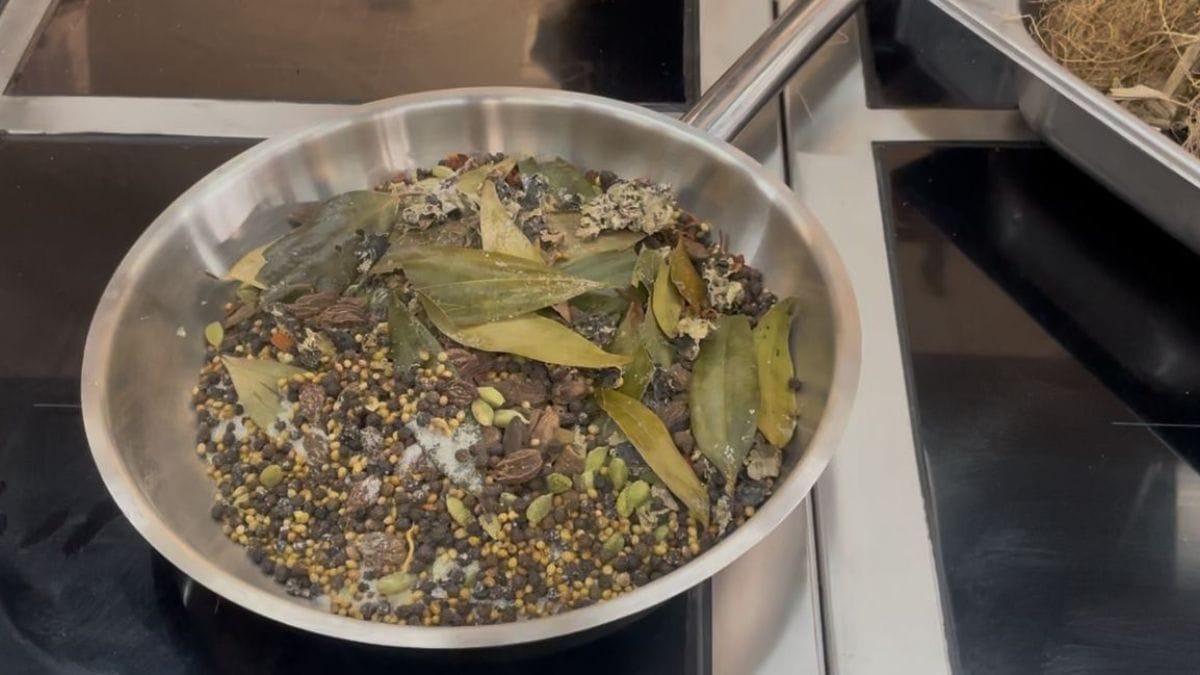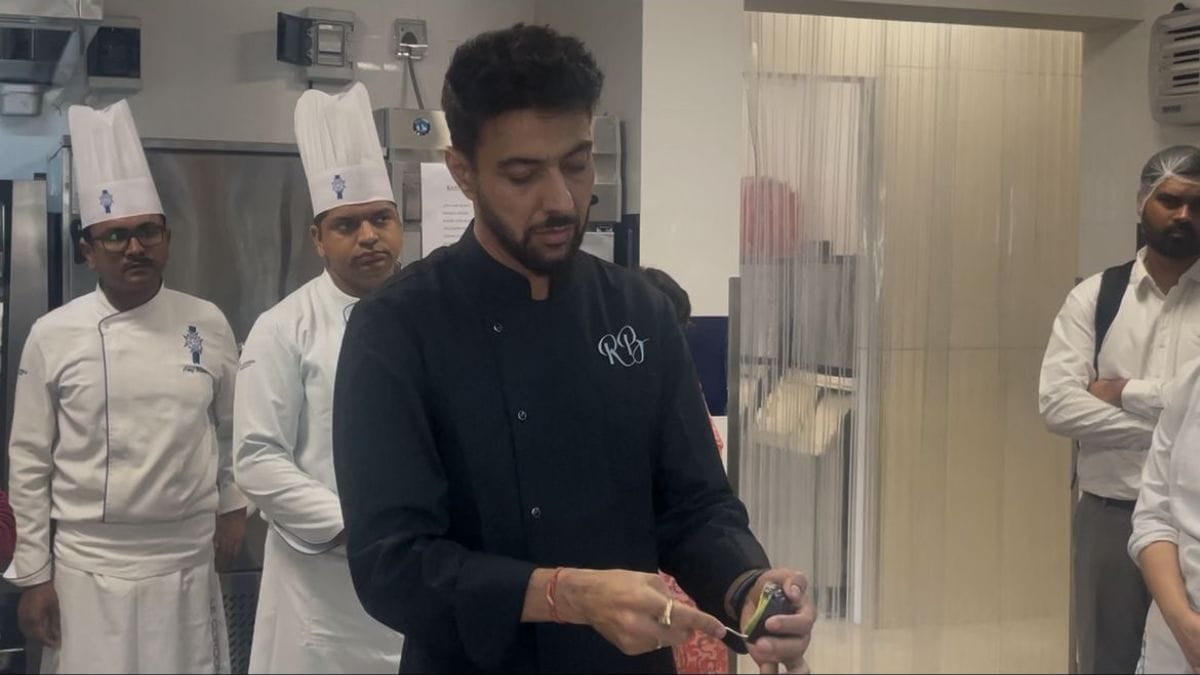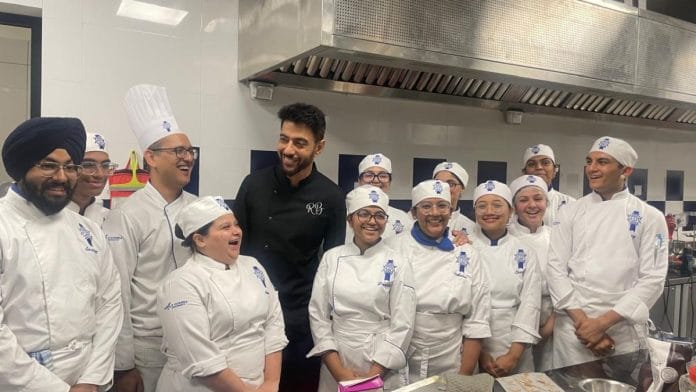Dressed in a black chef’s coat, Ranveer Brar heats a pan on the stove and adds spices one after the other: bay leaf, black cardamom, black pepper, star anise, stone flower, coriander seeds, and more. The Le Cordon Bleu kitchen in Gurugram then fills up with the rich aroma of the spice mix.
“Masala, or spice blends, are a lot like perfumes,” Brar explained to a group of students at Le Cordon Bleu (LCB), the GD Goenka Group’s hospitality and culinary institute, last week.
“Just as perfumes have multiple notes, every spice has three aromatic layers: the base, which is woody, the middle, which is fresh, and the top, which is floral.”
Brar encouraged the students to create their own unique spice blends, starting with at least five different spices. And, the composition should be guided by its intended use in cooking.
For a deep, foundational flavour, spices with an earthy character, like bay leaf and stone flower, are added at the beginning of the cooking. For example, when tempering dishes like rajma or chole, bay leaf is added to hot oil early on to impart a rich, grounding, and slightly mineral taste.
To build the body and flavour of a dish, spices are introduced mid-way through cooking. Coriander seeds, green cardamom, and black pepper are commonly used at this stage to add depth to the dish.
The final category of spices is used purely for finishing, added just before serving. Ingredients like saffron, rose petals, and kevda water fit the bill. They leave a fragrant top note that fades within 20 to 25 minutes, much like the fleeting top note of a perfume.
“But there are spices that touch all three layers, base, body, and top, though in different proportions,” Brar revealed, picking up a handful of the roasted spices and inhaling their aroma deeply.
“Take long pepper, one of my favorites: it’s about 50 per cent base, 40 per cent body, and 10 per cent top note. Cinnamon, on the other hand, is 30 per cent base, 60 per cent body, and 20 per cent top.”

Brar’s earliest memory of spices dates back to his childhood visits to a small ‘parchun ki dukaan’ (grocery store) in his neighborhood in Lucknow. He remembers Das Babu, the shopkeeper who introduced him to the variety of spices. “When I used to go there, he would ask me what kind of chilli I wanted, what type of salt—that was my first encounter with spices,” Brar recalled.
However, the chef warned that spices, while powerful, must not be used recklessly. Many chefs, while cooking Indian dishes, tend to hide behind spices to mask poorly executed dishes.
“Spices shouldn’t be used to confuse the palate. Its purpose is to enhance a dish, not to subdue it,” Brar told the students, highlighting that he uses his spice blend — the one he created in the kitchen — to finish off a biryani or a korma.
Also read: Delhi-NCR restaurants are caught in a cut-copy-paste mode, and a monopoly of consultants
‘Express through accents’
Dressed in their chef whites, students gather in the kitchen of Le Cordon Bleu. With notebooks and cameras in hand, their eyes shine with admiration as they hang on to every word spoken by Chef Brar.
Along with the spice workshop, Brar also spoke about the ever-growing ‘fusion’ trend that has taken over both social media and restaurant menus.
“Find subtle ways to express fusion—through garnishes and condiments,” he advised young chefs against making drastic changes to core dishes.

“Don’t go attacking the biryani. Experiment with the raita first. For example, when I wanted to bring Mexican flavours into biryani, I made an avocado raita.”
Turning to a student next to him, Brar asked for a few scoops of curd to be added to an empty bowl. Meanwhile, he diced an avocado and added it to the dish, followed by salt and a spoonful of chipotle in adobo sauce—a blend of smoked and dried jalapenos.
He went on to create two more fusion versions—one with a Korean flavour and another with Thai.
For the Korean-inspired raita, he mixed in gochujang sauce, candied tamarind, and pickled ginger. And the Thai variant had chopped pomelo, kaffir lime leaves, and the bird’s eye chilli.
“As culinary students, we are often torn between experimenting and not bastardising dishes. But Chef Ranveer’s tip of expressing through the side dishes is something I am going to follow going ahead,” one of the students said.
Westward culinary training
Brar was visibly energised by the response he received from the students. He described the experience as “surreal”.
“I am convinced that there is a solid group of young chefs coming up in the industry,” he said.
For Brar, spending time with students is a deeply fulfilling experience.
“Honestly, it’s a selfish act,” he admitted with a smile. “You take back far more energy than you give.”
He praised the new generation for being very secure in their cultural identity, highlighting that they are not constantly looking westward for validation. Addressing the dominance of French cuisine and Japanese techniques in Indian culinary education, Brar attributed it to one key factor: the lack of ‘documentation’ of Indian food.
“Education is about structure. And unfortunately, Western cuisines, especially French, are well-documented and have a formal structure. And that is why they become the foundation of culinary training,” he said.
Indian cuisine remains vastly understructured, not because it lacks depth, but because of its complexity and diversity.
“Indian food is incredibly vast and nuanced. To build a structure around it, we first need to document it, then analyse, strategise, and finally, create a structure for the students,” Brar said.
(Edited by Ratan Priya)






